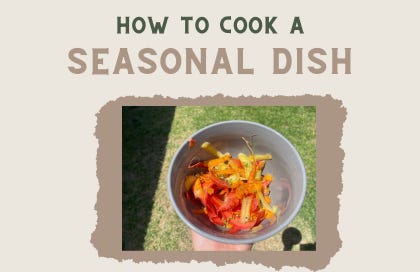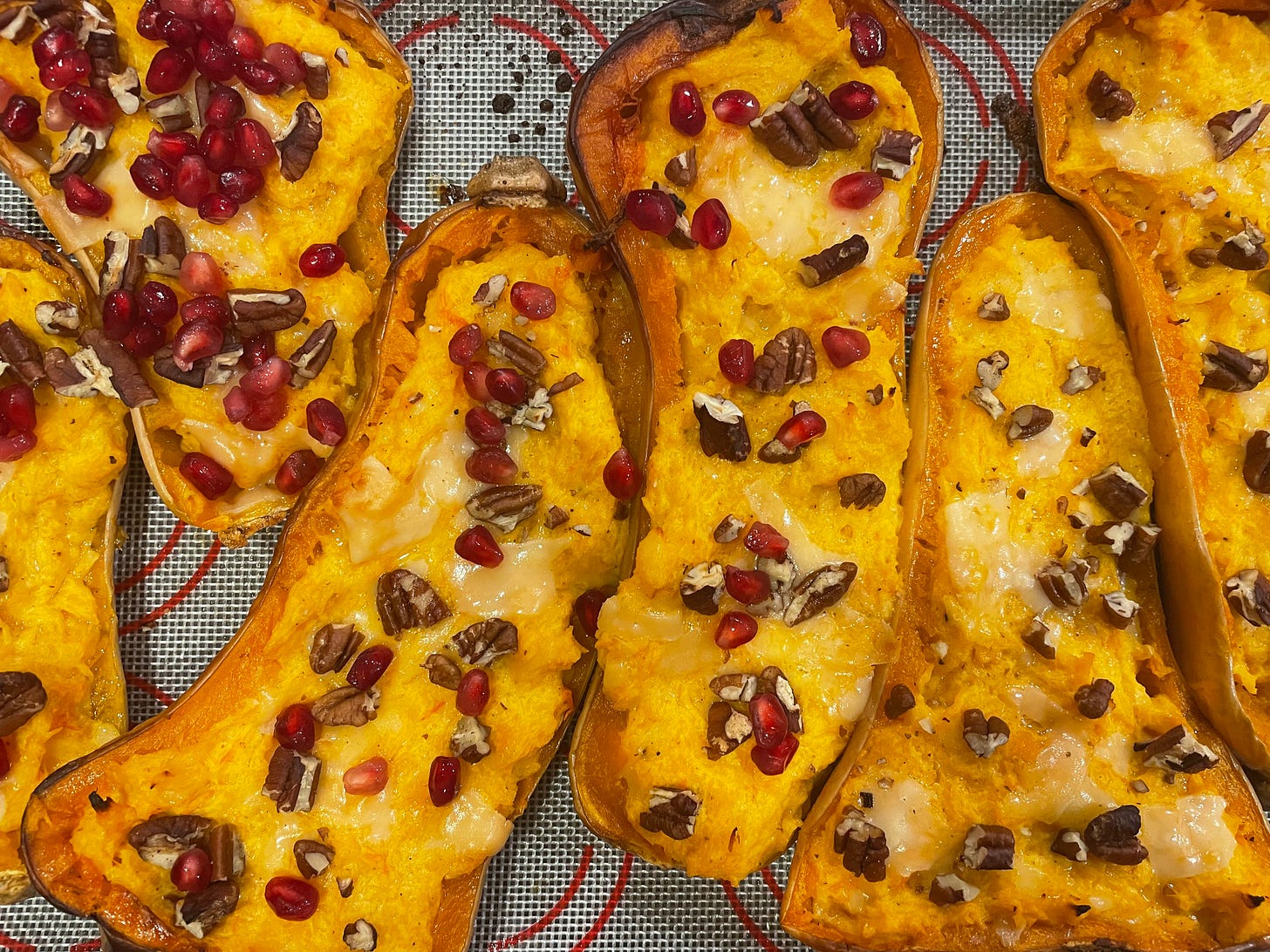How to Turn Any Seasonal Veggie into a Yummy Dish
No recipe required, just the basic laws of cooking
When cooking, many of us start with a recipe and gather the ingredients after.
By cooking this way, we lock ourselves into going to the grocery store to buy our food.
Why? Because all of the things in one recipe will never be found all at once at the farmer’s market. When we follow recipes, the ingredients are from all different seasons (unless cooking from a seasonal book).
Dill, which thrives in the Arizona winter. Cucumbers, which begin growing in the early summers. Onions and garlic, which are ready to harvest mid-spring.
When we follow recipes, we often defy the laws of nature. We assume we have whatever vegetable, herb, or fruit we want, when we want it, because of the abundance of food available at all times at the grocery store.
But what if you changed the way you cooked? What if you started with a Saturday morning, casual peruse around the farmer’s market? You could spend an hour or two bobbing through the different stands, imagining all of the fun recipes you could cook with the seasonal ingredients you find.
See, this is the real fun of the farmer’s market. Showing up and seeing what the farmers have in store for you that day. No agenda, no list, just pure imagination, letting your wondering taste buds lead you.
Now I know what some of you are thinking. What!? Come up with recipes on the fly!? How on Earth would I be able to do that?? I can barely cook as is.
I once thought I couldn’t cook anything. I would burn a piece of toast. I could barely cook an egg. Let alone whip up a from-scratch meal using only seasonal ingredients.
But then I learned the basic laws of cooking.
You see, cooking really isn’t that complicated. It’s not like baking where everything has to be meticulously measured to get the perfect rise and texture. You just need to have a few key ingredients in your pantry, knowing how to balance them.
Component 1: A High-Quality Oil (Fat)
There’s truly nothing that doesn’t compliment a high-quality extra virgin olive oil. There’s a reason Sebastian subscribes to a quarterly EVOO subscription that ships us some of the best olive oils from all over the world…
A high-quality oil like EVOO accentuates the natural flavors of anything you pair it with. EVOO with freshly sliced mozzarella? Delicious. EVOO on top of vanilla bean ice cream? Decadent. EVOO on arugula? Simple yet tasty.
Of course you can also use other sources of fat like a grass-fed ghee, beef tallow, or even nuts, but olive oil never lets me down.
Component 2: Acid
Next, to cut through a bit of the fat, you need an acid. This will make your dishes just a little bit brighter. When you think of an acid, you may automatically jump to vinegar. While vinegar is indeed an acid that can make any dish taste better, so is lemon juice, tomatoes, and wine.
My favorite acid to use is lemon juice, as it’s so easy and cheap. I almost always have a lemon in my kitchen!
Component 3: Salt
Salt can turn a dish from bland to perfectly enhanced. Sometimes the answer is really as simple as adding salt to your meal. I’m not sure when salt got such a bad rap, but salt is NOT bad for you.
Salt is a key mineral that your body needs to survive and thrive on a cellular level. Make sure you are using a high-quality one like Redmond’s or Celtic Sea Salt.
Also keep in mind that you can use different salts. There’s your typical sea salt but also something like Maldon’s which is large and flaky, adding a surprise element to your dishes.
Other Components
Once you have those three things, you can think about some of the more fun components to a dish. I always like to add something with a little crunch, typically a nut. Pistachios, toasted almonds, and pecans make anything taste better.
I also love to add some sort of cheese to enhance all of the other flavors. Cheese is acidic and can complement that other acid used, but also the fat, very well.
Then, of course, are all of the additional spices you can add! I think fresh herbs make for the best bet, as fresh herbs add an extra punch of flavor to everything. Cilantro, parsley, green onions, and dill are a few of my favorites.
Cooking Methods
Now let’s take it back to the star of the show- the main vegetable that you are cooking. Whether you are cooking beets, artichokes, brussel sprouts, or turnips, you can use a few different cooking methods.
First, you can steam. Second, you can roast. Third, you can sauté. Fourth, you can grill. I’ll be honest- I almost always roast my vegetables, as I think it unlocks the most flavor. I’m also most comfortable with it. You don’t have to baby the grill every few minutes, or worry about the vegetables getting too mushy.
Choose the cooking method that works for you!
Putting it all together…
So now that you understand the process, how does this actually work in theory? Let’s take a dish that I recently made with beets from our garden. I’ve been loving golden beets lately, as I planted a ton and they are both sweet and hearty.
Like I mentioned, I like to roast my vegetables. I sliced them up and tossed them in olive oil, baking in the oven until soft.
When they came out, I knew I wanted to add more olive oil and lemon juice. Lemon juice on beets taste amazing! After, I added the other core ingredient which is salt.
I gave them a taste and added some pepper. I also wanted to add a crunch to go with the softer vegetable. Pistachios! Not only do the colors look beautiful together, but the flavors complement each other well.
I tasted again and could tell them were missing something. I needed to pack a little more flavor in there. We were making lamb meatballs and tzatziki with the meal, so I had some feta and dill also laying around the kitchen. I crumbled the feta into the beets and topped with some chopped dill.
Bravo! I hit the winning combination. No recipe needed.
You really just need to keep tasting and experimenting until you get it just right. Not enough people taste their food before serving it! Your food usually only needs a small touch for it to taste restaurant-quality. Over time, your taste buds will become more sophisticated and know just what a dish needs.
Take action
Go to the farmers market this weekend without a recipe in mind and pick out one piece of produce that speaks to you. It could be something you’ve never cooked before, or something you cook all the time.
Go home and use the laws of cooking. Add a fat, acid, and some salt. See what else you can add to spruce it up! Better yet, you may be able to find some fresh cheese or herbs at the farmer’s market to compliment your new dish.
Reply to this newsletter with a picture or description of what you made! I’d love to see what you can come up with.
Have a great Sunday!
Madison Mae






